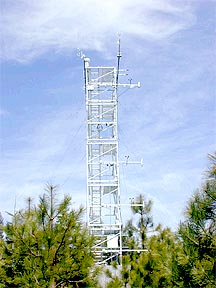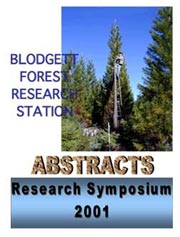 Ozone concentration and ecosystem scale fluxes were measured continuously from June 1999 to June 2000 above a ponderosa pine plantation at Blodgett Forest, an Ameriflux site located ~75 km northeast of Sacramento, CA (1300 m). Ponderosa pine is one of the plants most susceptible to ozone damage in the Sierra Nevada Mountains. Most previous studies on ozone deposition have focused on the summer months because that is when the highest ozone concentrations occur. However, lowered defense systems in fall, winter, and spring may make plants more susceptible to ozone damage during these times even though ozone concentration is lower. Our measurements show that ponderosa pine trees were most active during the summer but maintained a low level of activity during the fall, winter, and spring. Seasonal daytime mean ozone concentration for summer, fall, winter, and spring was 66 ppb, 55 ppb, 37 ppb, and 49 ppb, respectively (daytime defined as hours 800 – 1800 PST). Seasonal daytime mean ozone deposition velocity was 0.47 cm/s, 0.33 cm/s, 0.35 cm/s, and 0.41 cm/s, respectively for the same periods. This indicates that the ecosystem was effective at taking up ozone throughout the year. It is also notable that the ecosystem was more effective at taking up ozone in the winter than in the fall. Cumulative ozone flux for the year was 114 mmol/m2 with the contribution for each season being 37% for summer, 20% for fall, 16% for winter, and 27% for spring. While ozone deposition to this ecosystem was highest in the summer, the combined deposition during fall, winter, and spring was twice that of summer. We also found that the environmental variables that control stomatal conductance had varying effects on ozone deposition at different times of the year. Therefore, to understand the controls on ozone deposition and the effect of ozone on this and other ecosystems that remain physiologically active in non-summer months, it is critical to quantify ozone deposition on a year-round basis. Ozone concentration and ecosystem scale fluxes were measured continuously from June 1999 to June 2000 above a ponderosa pine plantation at Blodgett Forest, an Ameriflux site located ~75 km northeast of Sacramento, CA (1300 m). Ponderosa pine is one of the plants most susceptible to ozone damage in the Sierra Nevada Mountains. Most previous studies on ozone deposition have focused on the summer months because that is when the highest ozone concentrations occur. However, lowered defense systems in fall, winter, and spring may make plants more susceptible to ozone damage during these times even though ozone concentration is lower. Our measurements show that ponderosa pine trees were most active during the summer but maintained a low level of activity during the fall, winter, and spring. Seasonal daytime mean ozone concentration for summer, fall, winter, and spring was 66 ppb, 55 ppb, 37 ppb, and 49 ppb, respectively (daytime defined as hours 800 – 1800 PST). Seasonal daytime mean ozone deposition velocity was 0.47 cm/s, 0.33 cm/s, 0.35 cm/s, and 0.41 cm/s, respectively for the same periods. This indicates that the ecosystem was effective at taking up ozone throughout the year. It is also notable that the ecosystem was more effective at taking up ozone in the winter than in the fall. Cumulative ozone flux for the year was 114 mmol/m2 with the contribution for each season being 37% for summer, 20% for fall, 16% for winter, and 27% for spring. While ozone deposition to this ecosystem was highest in the summer, the combined deposition during fall, winter, and spring was twice that of summer. We also found that the environmental variables that control stomatal conductance had varying effects on ozone deposition at different times of the year. Therefore, to understand the controls on ozone deposition and the effect of ozone on this and other ecosystems that remain physiologically active in non-summer months, it is critical to quantify ozone deposition on a year-round basis.
|
Contact Author: M.R. Kurpius, Department of Environmental Science, Policy & Management, Ecosystem Science, 151 Hilgard Hall, University of California, Berkeley, CA 94720-3110, mbauer@nature.berkeley.edu
|

 Ozone concentration and ecosystem scale fluxes were measured continuously from June 1999 to June 2000 above a ponderosa pine plantation at Blodgett Forest, an Ameriflux site located ~75 km northeast of Sacramento, CA (1300 m). Ponderosa pine is one of the plants most susceptible to ozone damage in the Sierra Nevada Mountains. Most previous studies on ozone deposition have focused on the summer months because that is when the highest ozone concentrations occur. However, lowered defense systems in fall, winter, and spring may make plants more susceptible to ozone damage during these times even though ozone concentration is lower. Our measurements show that ponderosa pine trees were most active during the summer but maintained a low level of activity during the fall, winter, and spring. Seasonal daytime mean ozone concentration for summer, fall, winter, and spring was 66 ppb, 55 ppb, 37 ppb, and 49 ppb, respectively (daytime defined as hours 800 – 1800 PST). Seasonal daytime mean ozone deposition velocity was 0.47 cm/s, 0.33 cm/s, 0.35 cm/s, and 0.41 cm/s, respectively for the same periods. This indicates that the ecosystem was effective at taking up ozone throughout the year. It is also notable that the ecosystem was more effective at taking up ozone in the winter than in the fall. Cumulative ozone flux for the year was 114 mmol/m2 with the contribution for each season being 37% for summer, 20% for fall, 16% for winter, and 27% for spring. While ozone deposition to this ecosystem was highest in the summer, the combined deposition during fall, winter, and spring was twice that of summer. We also found that the environmental variables that control stomatal conductance had varying effects on ozone deposition at different times of the year. Therefore, to understand the controls on ozone deposition and the effect of ozone on this and other ecosystems that remain physiologically active in non-summer months, it is critical to quantify ozone deposition on a year-round basis.
Ozone concentration and ecosystem scale fluxes were measured continuously from June 1999 to June 2000 above a ponderosa pine plantation at Blodgett Forest, an Ameriflux site located ~75 km northeast of Sacramento, CA (1300 m). Ponderosa pine is one of the plants most susceptible to ozone damage in the Sierra Nevada Mountains. Most previous studies on ozone deposition have focused on the summer months because that is when the highest ozone concentrations occur. However, lowered defense systems in fall, winter, and spring may make plants more susceptible to ozone damage during these times even though ozone concentration is lower. Our measurements show that ponderosa pine trees were most active during the summer but maintained a low level of activity during the fall, winter, and spring. Seasonal daytime mean ozone concentration for summer, fall, winter, and spring was 66 ppb, 55 ppb, 37 ppb, and 49 ppb, respectively (daytime defined as hours 800 – 1800 PST). Seasonal daytime mean ozone deposition velocity was 0.47 cm/s, 0.33 cm/s, 0.35 cm/s, and 0.41 cm/s, respectively for the same periods. This indicates that the ecosystem was effective at taking up ozone throughout the year. It is also notable that the ecosystem was more effective at taking up ozone in the winter than in the fall. Cumulative ozone flux for the year was 114 mmol/m2 with the contribution for each season being 37% for summer, 20% for fall, 16% for winter, and 27% for spring. While ozone deposition to this ecosystem was highest in the summer, the combined deposition during fall, winter, and spring was twice that of summer. We also found that the environmental variables that control stomatal conductance had varying effects on ozone deposition at different times of the year. Therefore, to understand the controls on ozone deposition and the effect of ozone on this and other ecosystems that remain physiologically active in non-summer months, it is critical to quantify ozone deposition on a year-round basis.